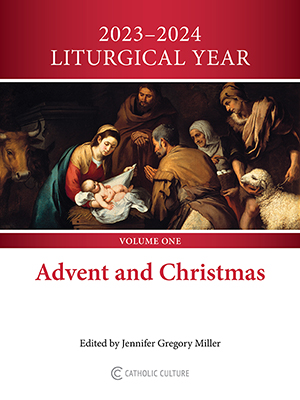Catholic Activity: Making a Baptismal Garment and Candle
Here is a wonderful way to deepen the understanding of Baptism with the family by making and decorating each child's baptismal garment and baptismal candle.
DIRECTIONS
It is a lovely custom for the family to provide their own baptismal garment and candle for a baby's Baptism. White garments can be bought ready-made and embroidered with liturgical symbols, or can be made and embroidered at home. Sometimes they are like a bib or sacque or, as in our family, a piece of fine linen cloth can be used for each child. This is embroidered with the symbols of each sacrament as the child receives them, and parts of it are appliquéd to a First Communion dress, a Confirmation dress, a wedding dress; or it can be made into a pocket handkerchief to carry at a boy's First Communion, Confirmation, his wedding, or even as an amice at Ordination.
The candle used at a Baptism (two are used, but one is handed to the sponsors) must fit the candlesticks in the baptistry; hence it is usually more convenient to have an ordinary-sized blessed candle, decorated either before or after with appropriate symbols and lettered with the child's name and the date. For baptismal feasts at home, there are large liturgical candles available at religious supply stores, currently priced under a dollar. These can be taken to the church before Candlemas (February 2), when Father will be glad to bless them with the rest of the candles.
Decorating a baptismal candle is not difficult, even for people who can't draw a straight line. Liturgical symbols are all over the place, in missals, prayerbooks, on the walls of churches, on altars and vestments, on religious greeting cards; if none is found to describe a child's patron saint it is quite all right to invent them. First, a thin coat of white shellac goes over each spot where a design will be painted. Shellac and a cheap paintbrush (shellac is death to good paintbrushes) can be bought at the Five and Ten, and shellac can be removed from brushes with rubbing alcohol.
Next, the designs are drawn or traced on paper with a soft lead pencil, then reversed and transferred to the candle by rubbing. Be sure to plan the spacing of the designs to leave enough room near the bottom of the candle for the child's name, date of birth, and date of Baptism. Oil paint with a little turpentine for thinning and a small pointed brush are best for the designs. After the paint is dry, another coat of shellac over them will be protection against handling.
The first three symbols at the top of our candles (reading down) are for the Holy Trinity, to remind the children that their souls become the dwelling of the Trinity after Baptism. There are many symbols for each Person, but we have chosen those easiest for the children to remember. A hand describes God the Father as Creator. The crown of thorns, three nails, and five drops of blood describe God the Son as Redeemer. A dove describes God the Holy Spirit. Very little children must have it clearly explained that the Holy Spirit is not a dove. A dove has been seen at times as a sign of the Holy Spirit, but the Holy Spirit is really the love of the Father for the Son, and the love of the Son for the Father.
Next comes a shell with water, because water is the most important outward sign of the sacrament of Baptism. Then we have used a cloud with wind, to remind them of the priest breathing three times gently on the face of the child at Baptism, bidding the evil spirit to depart in the name of the Holy Trinity. Next, a salt cellar with grains of salt. [Editor's Note: Salt is no longer used in the baptismal ceremony.] This is the symbol children love best because it is so interesting to see a baby taste the salt at his Baptism, and because it is symbolic of things they know in daily life. At home we use salt to bring out the flavor of our food and to preserve such things as cucumbers (pickles), cabbage (sauerkraut), and fish (codfish cakes). In Baptism a little blessed salt is put on the baby's tongue as a pledge that it may have a taste for heavenly wisdom, and that it may be preserved from the corruption of sin. It reminds us of the words of Our Lord: "You are the salt of the earth. But if the salt lose its savor, wherewith shall it be salted? It is good for nothing any more but to be cast out, and to be trodden on by men."
Then we put a little oil lamp, a symbol of the Holy Chrism with which a child is anointed after the pouring on of water. This is a sign that he is now a member of Christ's Mystical Body and has some share in the work of Christ's Priesthood. In this sense, he is a lay priest. He may offer the Mass with the priest and Christ, as an act of adoration to the Father. A man and a woman administer the sacrament of Matrimony to one another, with the priest present as witness. In this they act as lay priests.
Next, there is the white garment. This is a symbol of the gift of sanctifying grace which infuses the soul at Baptism. In the early Church the candidates for Baptism wore white garments, but more recently the priest has used a fine white napkin, laying it across the child's head. Last of all on the candle is the child's name and birth date, and then — lettered in red — the date of his Baptism.
Activity Source: We and Our Children by Mary Reed Newland, Image Books, 1961







